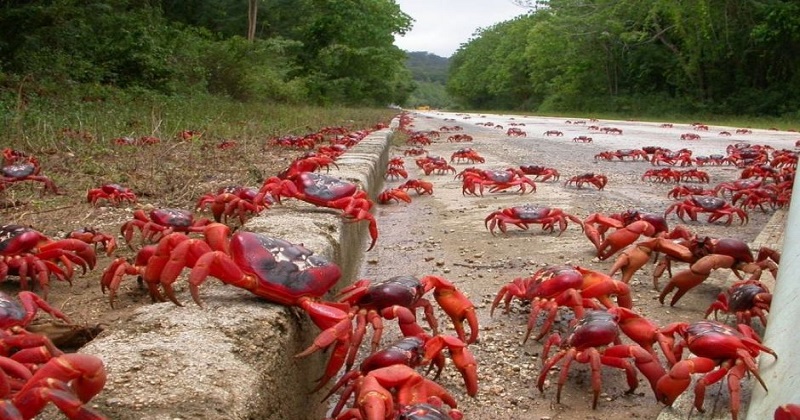
Christmas Island’s wet season has started, which means one thing: Millions of bright red crabs are on the move once again to mate and spawn – closing roads and turning up everywhere, as a local conservation agency says. Male crabs lead the way, followed by female crabs, as they migrate from the jungle to the Indian Ocean so they can mate in or near burrows by the water. Together, they march through towns, crossing specially-made crab bridges and covering everything in their path.
The Island is home to more than 50 million red crabs – the only place in the world where they can be found. A mass migration occurs every year on the island and is determined by the moon phase, according to Parks Australia, which calls it ‘one of the most incredible natural processes on Earth’.
Typically, the colorful migration occurs between October and November, but it has happened as late as December or January in the past. The crabs were everywhere, including at an office block’s door, Parks Australia tweeted this week, adding that the annual migration was in full swing. The government agency is keeping its staff busy ‘raking crabs off roads’ and managing road closures to keep the crustaceans safe.
It is an important annual event for the island – tourists and nature enthusiasts flock to coves and beaches to see the crabs’ tortuous journey, while others tune in to local radio stations for travel advice and migration updates. Christmas Island’s acting manager, Bianca Priest, said workers were taking precautions to help the creatures with their annual migration.
In order to protect the crabs, staff at Christmas Island National Park erect temporary barriers, place signs, and close roads across the island, she told Daily Mail Australia on Wednesday. In addition, officials have been known to build bridges, underpasses, and crossings to help the creatures migrate safely. Visitors who are keen to see the mass migration cannot drive on certain roads, but they are welcome to walk among the crawling crabs.
In addition to contributing to the island’s biodiversity, crabs eat leaf litter, which keeps the forest floor healthy. Parks Australia says crabs are crucial to the survival of the island’s ecosystem by eating leaf litter. The agency says that human activities have led to a higher number of crab deaths during the annual migration, with thousands crushed by cars each year and others at risk of dehydration when they pass through areas of cleared forest.
Immediately after mating within the burrows, the females – who greatly outnumber the males – stay until they are ready to lay eggs, which takes about three days. As the eggs develop, they remain in the burrows for a fortnight until they are ready to release them into the ocean. During the spawning process, females swarm the shoreline to release their eggs into the sea. According to Parks Australia, this process can occur on five or six consecutive nights during this period.
Read more: ‘Sacred India’: Ancient temple towns are becoming icons of cleanliness
Baby crabs hatch from the eggs deposited by the crabs if the larvae are not eaten by hungry fish, manta rays, or giant whale sharks. The larvae are often devoured completely, leaving no baby crustaceans, but experts believe once or twice a decade there is a larger number that survives, maintaining the population numbers. The natural migration process is so impressive that world-famous naturalist Sir David Attenborough called it ‘an astonishing, wonderful sight’.
The creatures treated him as though he was just another obstacle in their path toward the sea, climbing up his legs when they continued their journey. ‘It’s like a scarlet curtain moving down the cliffs and rocks toward the sea. That’s how I discovered how difficult it is to cast lines while several four-inch crabs, each with a sharp claw, advance menacingly up your inner thigh,’ he laughed.

Post Your Comments